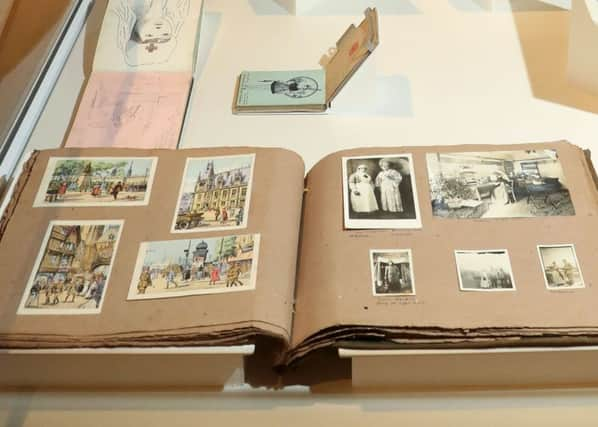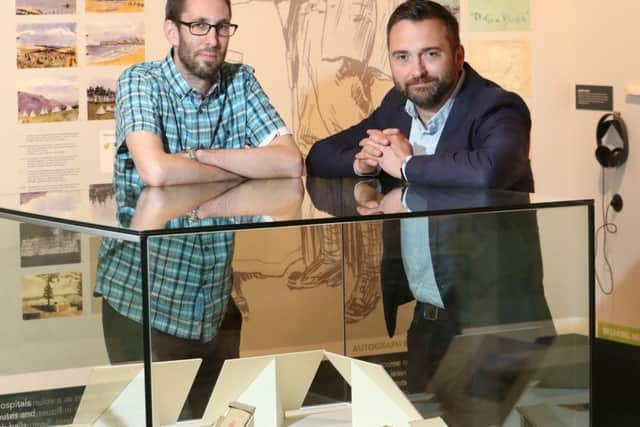Art by WW1 recovering soldiers goes on display


The historical treasure trove vividly encapsulating life and death in World War One was owned by Co Down nurse Olive Swanzy, who urged her patients toward artistic endeavours to aid their recovery.
The collection is being shown in the Ulster Museum, Belfast, as part of a new exhibition exploring how creativity and innovation were able to flourish amidst the horrendous destruction of war.
Advertisement
Hide AdAdvertisement
Hide AdThe wartime diaries of Jim Maultsaid, an Irish American soldier who served with the 14th Battalion of the Royal Irish Rifles and was seriously wounded on the first day of the Battle of the Somme, are also showcased in the exhibition.


A talented artist herself, nurse Swanzy’s sketchbooks include watercolour scenes from the front painted by herself during spare time away from tending to the injured at a hospital in Rouen in northern France.
Robert Whan, history engagement officer with National Museums Northern Ireland, explained how the rare collection came into the museum’s ownership.
“Olive died in 1974 and all this was in her attic and discovered by the new owner of the house, which was near Rostrevor, Co Down,” he said.
Advertisement
Hide AdAdvertisement
Hide Ad“That lady was downsizing and moved to Finland in the 1990s and a friend of hers was an artist and she thought she might be interested in this so she gave it to her.


“She then put it in a suitcase in her attic and it remained there for another decade or two - and then she just happened to be looking through and she rediscovered it again.
“At that stage she recognised the importance and value of it and donated it to the Ulster Museum earlier this year.
“It’s a very great acquisition for us.”
The Creative Centenaries #MakingHistory 1916 Exhibition at the Ulster Museum opens on Friday and is free to attend.
Advertisement
Hide AdAdvertisement
Hide AdThe five zone exhibition is led by the Nerve Centre arts organisation, delivered in partnership with National Museums Northern Ireland, and supported by the Heritage Lottery Fund, Department for Communities, Community Relations Council and the Department of Foreign Affairs & Trade.
Other artworks include a giant handmade drone “war rug” commissioned by Dublin-based artist Jim Ricks and made by a family in Kabul, Afghanistan, which visitors will be able to sit on, and the well-known “Armoured Pram for Derry” sculpture by Eamon O’Doherty.
David Lewis, director of communications and digital content at Nerve Centre, said: “This major interactive exhibition brings together music, art, illustration, early animations and never-seen-before archive material to highlight how ordinary people, both at home and on the front line, helped shape history.
“It is the latest exciting output from the Nerve Centre’s Creative Centenaries project which uses digital technologies to explore our past in an inclusive, respectful way.”
Advertisement
Hide AdAdvertisement
Hide AdNational Museums Northern Ireland’s head of history, William Blair, said: “This exhibition powerfully conveys how war can act as a catalyst for change, impacting on all aspects of life and driving change in society, politics and technology.
“National Museums Northern Ireland are delighted to have been involved in delivering #MakingHistory 1916. It has been a genuinely collaborative project, pooling resources and expertise from organisations across Northern Ireland. The result of this collaboration is an engaging, thought provoking and interactive exhibition which will appeal to all ages.”
Paul Mullan, head of HLF Northern Ireland, said: “Past events within the Decade of Centenaries still have huge importance for us today, shaping our understanding of ourselves, our communities and our future.
“It is with thanks to National Lottery players that we can support this 1916 exhibition and programming at the Ulster Museum. The use of new and exciting technology will interest and inspire a wide range of audiences with the heritage, and we are delighted to be involved.”